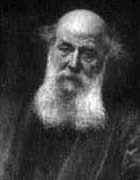Person: Sylvester, James Joseph

J J Sylvester did important work on matrix theory. He discovered the discriminant of a cubic equation and first used the name 'discriminant' for equations of higher order.
Mathematical Profile (Excerpt):
- Sylvester attended two schools in London, the first one being a boarding school in Highgate which he attended up to 1827, after which he undertook a further eighteen months study at a school in Islington.
- However things did not go well for Sylvester for, when only five months into his studies, he was accused of threatening a fellow student with a knife in the College refectory.
- On 7 July 1831 Sylvester matriculated as a student at St John's College, Cambridge, although his studies were interrupted when he was forced to take most of the two years 1833-34 and 1834-35 out due to a lengthy illness.
- Two other famous mathematicians took the tripos examination in the same year as Sylvester, namely Duncan Gregory and George Green.
- Sylvester came second, Green who was 20 years older than the other two came fourth, with Duncan Gregory fifth.
- At this time it was necessary for a student to sign up to the Thirty-Nine Articles of the Church of England before graduating and Sylvester, being Jewish, naturally refused to take the necessary oath so could not graduate.
- For the three years from 1838 Sylvester held the chair of natural philosophy at the University of London, one of the few places which did not bar him because of his religion.
- However Sylvester was a mathematician and it was mathematics, not physics, that he wished to teach.
- Sylvester might have been a professor for three years but he still had no degree for the reason we indicated above.
- A student who had been reading a newspaper in one of Sylvester's lectures insulted him and Sylvester struck him with a sword stick.
- The student collapsed in shock and Sylvester believed (wrongly) that he had killed him.
- It is also likely that they reacted more against Sylvester as a foreigner although there are many records of abusive behaviour before Sylvester arrived.
- Certainly Sylvester complained to the Faculty on 1 February 1842 about the behaviour of a particular first year student.
- The abuse suffered by Sylvester from this student got worse after this.
- Sylvester objected to the lenient attitude of the Faculty on 19 March and resigned three days later.
- On his return to England Sylvester worked as an actuary and was secretary at the Equity Law and Life Assurance Company.
- Sylvester tried hard to return to being a professional mathematician and he applied for a lectureship in geometry at Gresham College, London in 1854 but he was not appointed.
- Another failed application was for the chair in mathematics at the Royal Military Academy at Woolwich, but, after the successful applicant died within a few months of being appointed, Sylvester became professor of mathematics at Woolwich.
- Sylvester did important work on matrix theory, a topic in which he became interested during walks with Cayley while they were at the courts of Lincoln's Inn.
- Sylvester became the second president of that Society in 1866.
- Being at a military academy Sylvester was forced to retire at age 55.
- Clearly Sylvester was proud of this work, entitled The Laws of Verse, since after this he sometimes signed himself "J J Sylvester, author of The Laws of Verse".
- For three years Sylvester appears to have done no mathematical research but then Chebyshev visited London and the two discussed mechanical linkages which can be used to draw straight lines.
- After working on this topic Sylvester lectured on it at an evening lecture entitled On recent discoveries in mechanical conversion of motion which he gave at the Royal Institution.
- Kempe and Sylvester worked jointly on linkages and made important discoveries.
- In 1877 Sylvester accepted a chair at Johns Hopkins University and he founded in 1878 the American Journal of Mathematics, the first mathematical journal in the United States.
- The seven years that Sylvester spent at Johns Hopkins saw a resurgence in his mathematical interests.
- Sylvester certainly wanted to return to his native land and had some personal reasons to return.
- When Smith died in 1883 Sylvester, although 68 years old at this time, was appointed to the Savilian chair of Geometry at Oxford.
- However Sylvester only liked to lecture on his own research and this was not well liked at Oxford where students wanted only to do well in examinations.
- In 1892, at the age of 78, Oxford appointed a deputy professor in his place and Sylvester, by this time partially blind and suffering from loss of memory, returned to London where he spent his last years at the Athenaeum Club.
- Sylvester never wrote a paper without foot-notes, appendices, supplements, and the alterations and corrections in his proofs were such that the printers found their task well-nigh impossible.
- Sylvester satisfied the popular idea of a mathematician as one lost in reflection, and high above mundane affairs.
- Sylvester was an orator, and if not a poet, he at least prided himself on his poetry.
- Sylvester sent the following puzzle to the Educational Times.
Born 3 September 1814, London, England. Died 15 March 1897, London, England.
View full biography at MacTutor
Tags relevant for this person:
Algebra, Geometry, Origin England, Number Theory, Special Numbers And Numerals
Thank you to the contributors under CC BY-SA 4.0! 

- Github:
-

- non-Github:
- @J-J-O'Connor
- @E-F-Robertson
References
Adapted from other CC BY-SA 4.0 Sources:
- O’Connor, John J; Robertson, Edmund F: MacTutor History of Mathematics Archive
